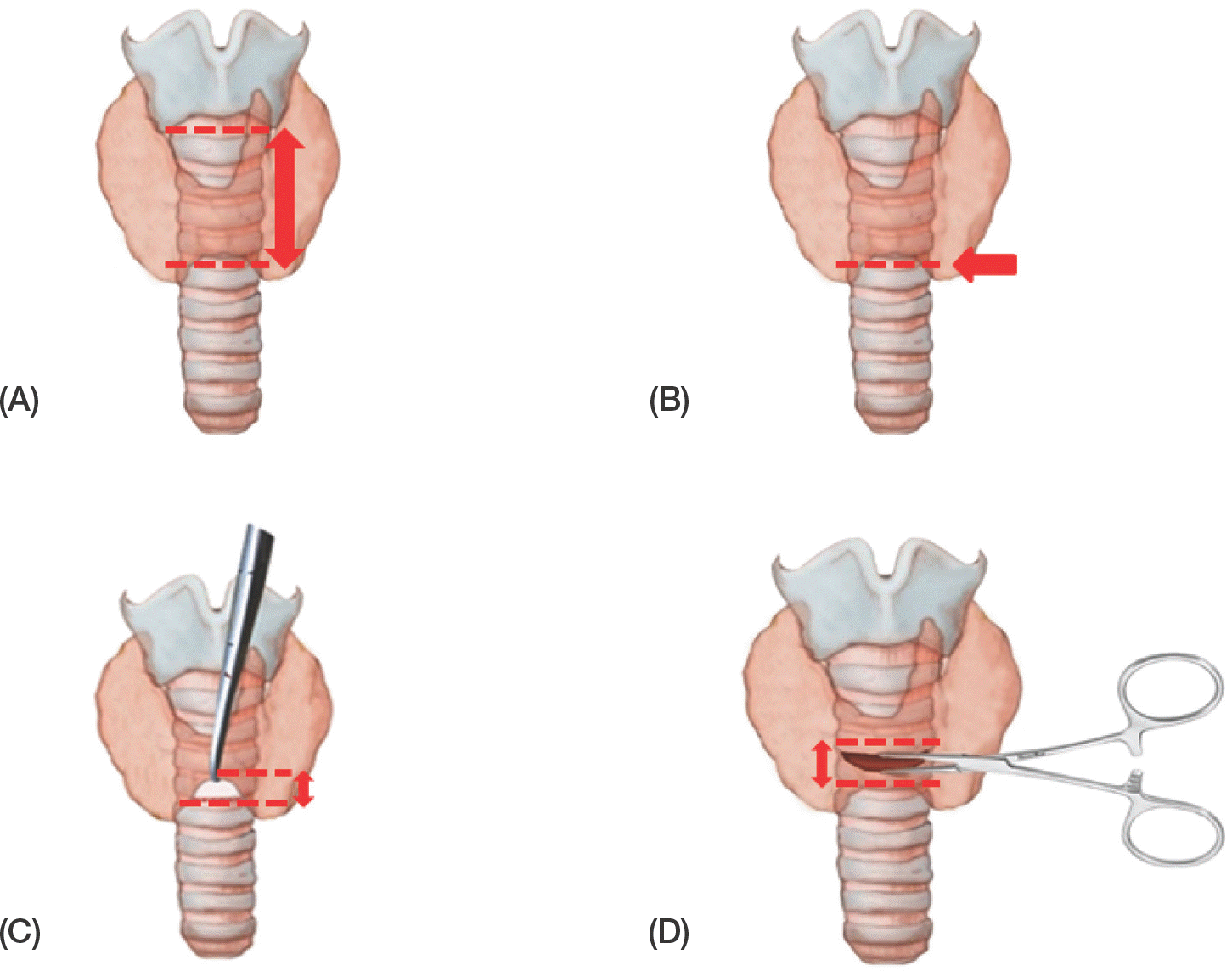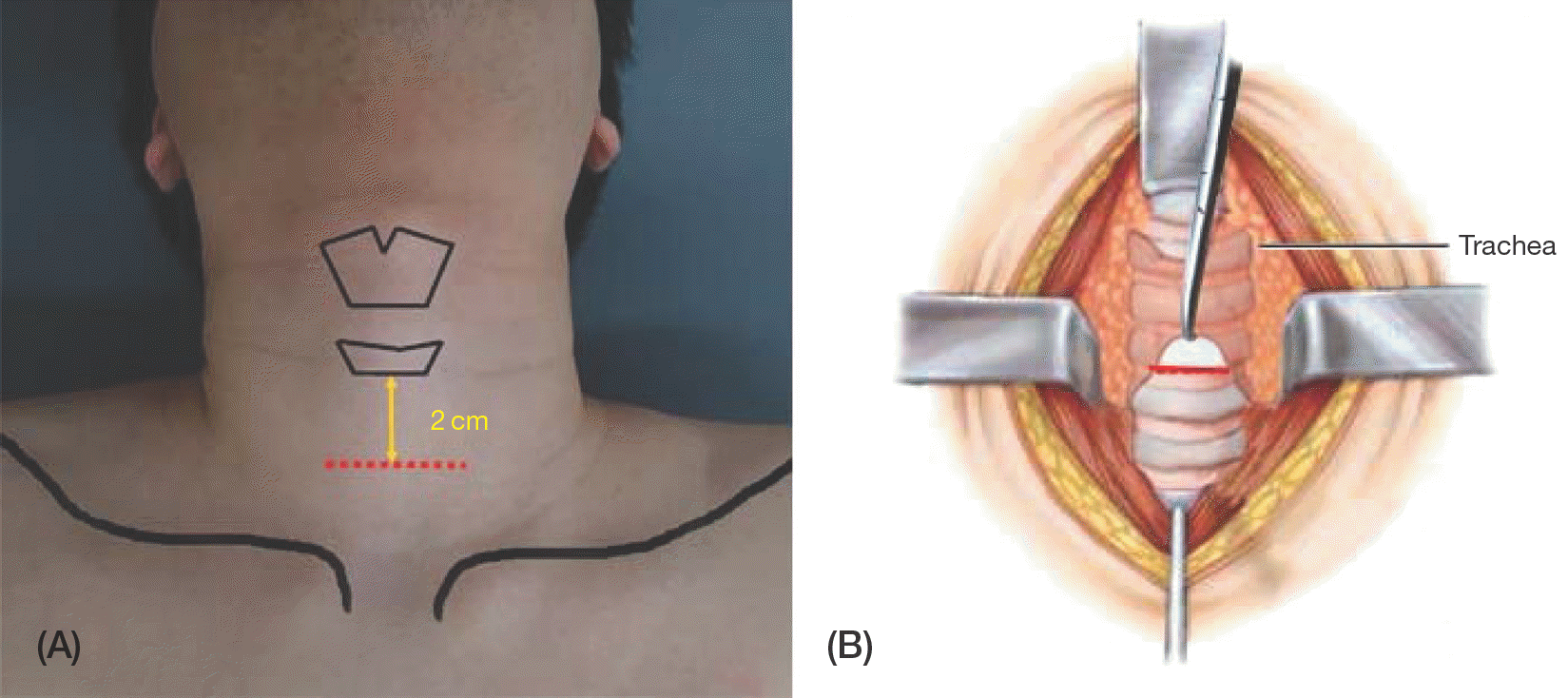Abstract
References
 | Fig. 1.Schematic illustration of variables used in this study. Figure shows distance between cricoid cartilage to the lower margin of thyroid isthmus (A), the level of thyroid isthmus lower margin compared with tracheal ring number (B, dotted line), movability of thyroid istchmus (C), maximal widened distance between the lower margin of upper tracheal cartilage and the upper margin of lower tracheal cartilage (D). |
 | Fig. 2.Schematic illustration of Minimally invasive horizontal intercartilaginous incision technique. The skin incision is made 2 cm below the center of the cricoid cartilage to exposure the inferior border of thyroid isthmus (A). The inferior border of thyroid isthmus is identified and retracted upward to expose the 2nd and the 3rd tracheal ring or the 3rd and the 4th tracheal ring (B). The annular ligament between the 2nd and the 3rd tracheal ring or the the 3rd and the 4th tracheal ring is identified, and an intercartilaginous incision was made. |
Table 1.
A. distance between cricoid cartilage to the lower margin of thyroid isthmus B. the level of thyroid isthmus lower margin compared with the number of tracheal ring C. movability of thyroid isthmus D. maximal widened distance between the lower margin of upper tracheal cartilage and the upper margin of lower tracheal cartilage
Table 2.
| Male | Female | p-value‡ | |
|---|---|---|---|
| Number | 12 | 8 | |
| Age | 72.4±13.2 | 79.5±21.3 | .101 |
| Factor A | 22.3±6.5 | 20.1±0.9 | .343 |
| Factor B (3/4/5) | 2/8/2 | 0/7/1 | 0.603 |
| Factor C | 8.9±3.5 | 8.3±2.2 | 1.000 |
| Factor D | 9.8±2.1 | 11.1±1.3 | .098 |
∗ Plus-minus values are means standard deviation. Factor A denotes distance between cricoid cartilage to the lower margin of thyroid isthmus. Factor B, the level of thyroid isthmus lower margin compared with tracheal ring number: Factor C, movability of thyroid isthmus: Factor D, maximal widened distance between the lower margin of upper tracheal cartilage and the upper margin of lower tracheal cartilage.
Table 3.
| Age<65 Age≥65 | p-value‡ | |
|---|---|---|
| Number | 6 14 | |
| Age | 54.5 + 12.3 84.1 + 8.3 | 0.000 |
| Factor A | 21.5 + 5.1 21.3 + 5.3 | 0.353 |
| Factor B (3/4/5) | 0/6/0 2/9/3 | 0.260 |
| Factor C | 8.0 + 1.7 8.9 + 3.4 | 0.062 |
| Factor D | 10.3 + 1.6 10.3 + 2.1 | 0.841 |
∗ Plus-minus values are means standard deviation. Factor A denotes distance between cricoid cartilage to the lower margin of thyroid isthmus. Factor B, the level of thyroid isthmus lower margin compared with tracheal ring number: Factor C, movability of thyroid isthmus: Factor D, maximal widened distance between the lower margin of upper tracheal cartilage and the upper margin of lower tracheal cartilage.




 PDF
PDF ePub
ePub Citation
Citation Print
Print


 XML Download
XML Download